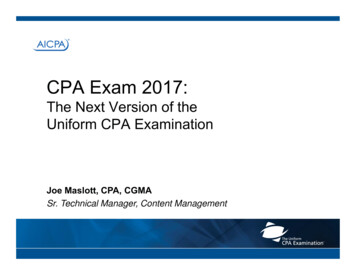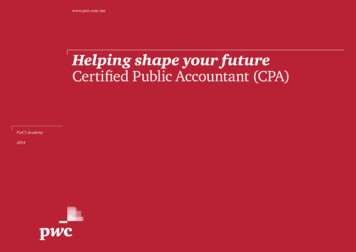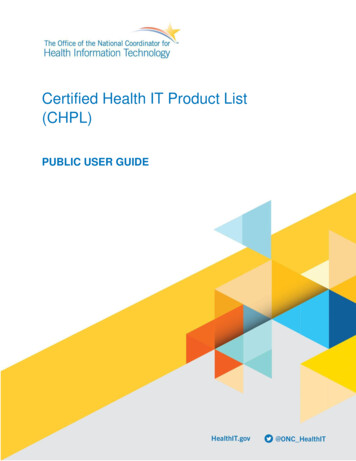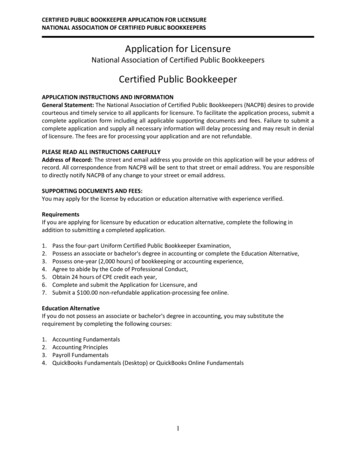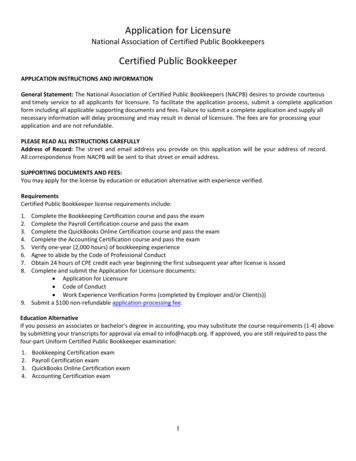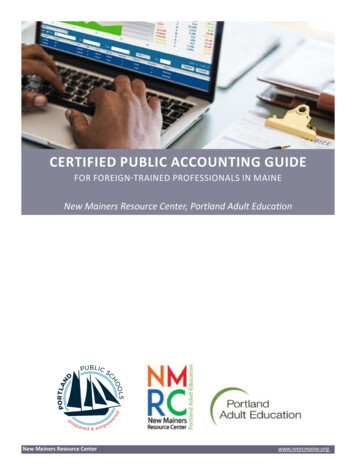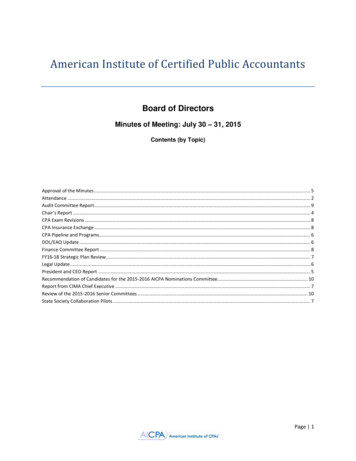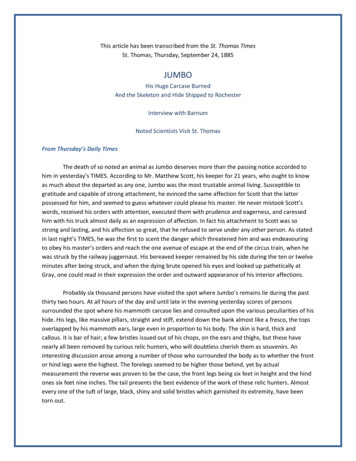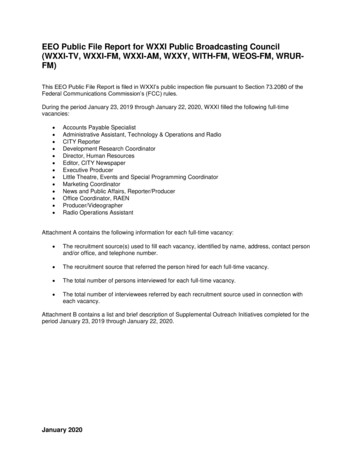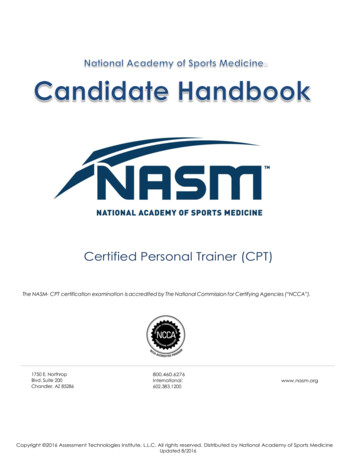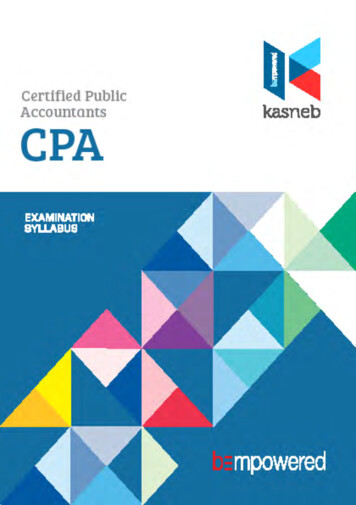
Transcription
SUMMARY OF THE CERTIFIED PUBLIC ACCOUNTANTS (CPA) EXAMINATIONREVISED SYLLABUSPart ISection 1Paper No. 1Paper No. 2Paper No. 3Financial AccountingCommercial LawEntrepreneurship and CommunicationSection 2Paper No. 4Paper No. 5Paper No. 6EconomicsManagement AccountingPublic Finance and TaxationPart IISection 3Paper No. 7Paper No. 8Paper No. 9Company LawFinancial ManagementFinancial ReportingSection 4Paper No. 10Paper No. 11Paper No. 12Auditing and AssuranceManagement Information SystemsQuantitative AnalysisPart IIISection 5Paper No. 13Paper No. 14Paper No. 15Strategy, Governance and EthicsAdvanced Management AccountingAdvanced Financial ManagementSection 6Paper No. 16Paper No. 17Paper No. 18Advanced Public Finance and TaxationAdvanced Auditing and AssuranceAdvanced Financial Reporting
PART ISECTION 1PAPER NO.1 FINANCIAL ACCOUNTINGGENERAL OBJECTIVEThis paper is intended to equip the candidate with knowledge, skills and attitudes that willenable him/her to prepare financial statements for different entities.1.0LEARNING OUTCOMESA candidate who passes this paper should be able to: Prepare books of original entry and basic ledger accounts under double entrysystemPrepare basic financial statements of sole traders, partnerships, companiesand manufacturing entities and not for profit organisationsComply with the regulatory framework in the accounting fieldAccount for assets and liabilitiesAnalyse financial statements by use of ratios and statement of cash flowsCONTENT1.1Introduction to accountingThe nature and purpose of accountingObjectives of accountingUsers of accounting information and their respective needsThe accounting equationRegulatory framework of accounting (regulatory bodies such as ICPAK, IFAC,IASB, IPSASB)Accounting standards (IASs/IFRSs) (importance and limitations)Professional ethicsAccounting concepts/principlesQualities of useful accounting information1.2Recording transactionsSource documents: quotations, purchase orders, statement of account,remittance advice, receipts, petty cash vouchers, sales and purchase invoice,credit notes and debit notes, bank statementsBooks of original entry: sales journal, purchases journal, returns inwardsjournal, returns outward journal, cash book, petty cash book and generaljournalDouble entry and the ledger; use of T- accounts and double entry aspects(debit and credit), sales ledger and purchases ledgerThe trial balanceComputerised accounting systems - Role of computers, application andaccounting softwares in the accounting process, benefits and challenges ofoperating computerised accounting systemsCertified Public Accountants (CPA) Examination Syllabus-1-
1.3Accounting for assets and liabilities1.3.1 AssetsProperty, plant and equipment – recognition, capital and revenueexpenditure, measurement (depreciation and revaluation), disposaland disclosures, property, plant and equipment scheduleIntangible assets – recognition, measurement (amortisation,impairment and revaluation), disposals and disclosuresFinancial assets – examples and categories onlyInventory – recognition, measurement and valuation using specific costmethod, FIFO and weighted average cost onlyTrade receivables – bad debts and allowance for doubtful debts andreceivables control accountsAccrued income and prepaid expensesCash at bank – cash book and bank reconciliation statementCash in hand – cash book and petty cash books1.3.2LiabilitiesBank overdraft – cash book and bank reconciliation statementTrade payables – control accountsLoans – accounting treatment of repayment of principal and interestPrepaid incomes and accrued expenses1.4Correction of errors and suspense account1.5Financial statements of a sole traderIncome statementStatement of financial positionPreparing financial statements under incomplete information1.6Financial statements of a partnershipPartnership agreementDistinction between current and fixed capitalIncome statementStatement of financial positionChanges in partnership – admission of a new partner, retirement and changein profit sharing ratio1.7Financial statements of a companyTypes of share capital – ordinary shares and preference sharesIssue of shares (exclude issue by instalment and forfeiture)Types of reserves – share premium, revaluation reserve, general reservesand retained profitsIncome tax - Accounting treatment and presentation (exclude computation)Financial statements – income statement and statement of financial positionPublished financial statements (describe a complete set of published financialstatements but not preparation)1.8Financial statements of a manufacturing entityFeatures of a manufacturing entityClassification and apportioning costs between manufacturing and selling andadministrationFinancial statements – manufacturing account, income statement andstatement of financial positionCertified Public Accountants (CPA) Examination Syllabus-2-
1.9Financial statements of a not for profit organisationFeaturesTypes of funds and their accounting treatmentIncome and expenditure accountStatement of financial position1.10Analysing financial statementsStatement of cash flows (categories of cash, methods of preparing statementof cash flows and the importance)Financial ratios – definition, categories, analysis and interpretation, applicationand limitations1.11Introduction to Public Sector AccountingFeatures of public sector entities (as compared to private sector)Structure of the public sector (National and county governments, statecorporations and other agencies)Regulatory structures and oversight [IPSASB, PSASB (establishment,mandate and functions), Director of Accounting Services, National Treasury,Parliamentary Committees, Accounting Officers at national and county levels]Objectives of public sector financial statementsObjectives of IPSASAccounting techniques in public sector (budgeting, cash, accrual, commitmentand fund)(Preparation of financial statements excluded)1.12Emerging issues and trendsCertified Public Accountants (CPA) Examination Syllabus-3-
PAPER NO.2 COMMERCIAL LAWGENERAL OBJECTIVEThis paper is intended to equip the candidate with knowledge, skills and attitudes that willenable him/her to apply the principles and provisions of commercial law in various businessenvironments2.0LEARNING OUTCOMESA candidate who passes this paper should be able to: Apply general principles of commercial law in business Identify the various dispute resolution mechanisms Demonstrate knowledge of legal personality Describe the different types of property Apply the law of contract in various scenariosCONTENT2.1Introduction to Law2.1.1Nature, purpose and classification of law- Meaning, nature and purpose of law- Classification of law- Law and morality2.1.2Sources of law- The Constitution- Legislation- Substance of common law and doctrines of equity- African customary law- Islamic law- Judicial precedent- General rules of international law and ratified treaties2.1.3Administrative law- Meaning- Doctrine of separation of powers- Natural justice- Judicial control of the ExecutiveThe court system- Structure, composition and jurisdiction of courts- Magistrate courts- Courts martial- Kadhis courts- TribunalsCertified Public Accountants (CPA) Examination Syllabus2.1.4-4-
2.1.5The High CourtEnvironment and Land CourtIndustrial CourtCourt of AppealSupreme CourtLaw of persons- Types of persons: natural person, artificial person- Nationality, citizenship and domicile- Unincorporated associations- Corporations- Co-operative societies2.2 Law of tort- Nature of tort- Vicarious liability- Strict Liability- Negligence- Nuisance- Trespass- Defamation- Occupiers liability- General defences in the law of tort- Limitation of actions2.3 Law of contract- Definition and nature of a contract- Classification of contracts- Formation of a contract- Terms of a contract- Vitiating factors- Illegal contracts- Discharge of contract- Remedies for breach of a contract- Limitation of actions2.4 Sale of goods- Nature of the contract- Formation of the contract- Terms of the contract- Transfer of property and title in goods- Rights and duties of the parties- Auction salesCertified Public Accountants (CPA) Examination Syllabus-5-
-International contracts of sale: FAS, FOB, CIF, FCA, CPT, CIP, DAT, DAP,DDP, CFR, DAF, DES, DDU, Ex-works and Ex-ship2.5 General principles of consumer credit- Nature of the hire purchase contract- Difference between hire purchase and conditional sale/credit sale- Formation of the hire purchase contract- Terms of the hire purchase contract- Rights and duties of the parties- Termination and completion of the hire purchase contract2.6 Indemnity and Guarantees- Nature of the contracts- Rights and duties of the parties- Advantages and disadvantages of guarantee as security- Termination of contract of guarantee2.7 Partnership- Nature of partnership- Relations of partners to persons dealing with them- Relations of partners to one another- Rights, duties and liabilities of existing, incoming, outgoing and minor partners- Dissolution of partnership and its consequences2.8 Insurance- Nature of the contract- Formation of the contract- Principles of insurance- Types of insurance2.9 Agency- Meaning, nature and creation of agency- Types of agents- Rights and duties of the parties- Authority of an agent- Termination of agency2.10 Negotiable instruments- Nature and characteristics- Negotiability and transferability- Types: cheques, promissory notes, bills of exchange- Rights and obligations of the partiesCertified Public Accountants (CPA) Examination Syllabus-6-
2.11 The law of property- Definition of property- Classification of property (real and personal, movable and immovable, tangibleand intangible)- Property in land: Private, Public and Community land- Interests in land: estates, servitudes and encumbrances- Intellectual property: plant breeder’s patents, trademarks, copyrights andindustrial designs2.12 Resolving commercial disputes- Nature and problems associated with commercial litigation- Arbitration- Mediation- Negotiation2.13 Emerging issues and trendsCertified Public Accountants (CPA) Examination Syllabus-7-
PAPER NO.3 ENTREPRENEURSHIP AND COMMUNICATIONGENERAL OBJECTIVEThis paper is intended to equip the candidate with knowledge, skills and attitudes that willenable him/her to apply entrepreneurial and communication skills in business and otherenvironments3.0LEARNING OUTCOMESA candidate who passes this paper should be able to: Identify and screen viable business opportunitiesDevelop a business planDemonstrate entrepreneurial orientationCommunicate effectively in a business environmentApply entrepreneurial competencies in response to the emerging trends in thebusiness environmentCONTENT3.1Introduction to entrepreneurshipDefinition of entrepreneurshipRationale for entrepreneurshipEntrepreneurial decision processEntrepreneurial developmentContribution to economic development3.2Entrepreneurship orientationIndependence and need for achievementIndividual characteristics of entrepreneursCreativity and innovationDecision makingRisk managementTime managementCoping with competition3.3Entrepreneurial opportunity and developmentMethods of generating ideasQualities of good business opportunitiesEvaluating business opportunitiesFeasibility analysisBusiness incubationIntellectual properties, copyrights trademarks and patents3.4Business planPurposeFormatDescription of the businessThe market and marketing planOperations and production planThe human resources planThe financial planLaunching the new ventureCertified Public Accountants (CPA) Examination Syllabus-8-
3.5Strategies for enterprise growthPenetration strategyMarket development strategyProduct development strategyFranchisingJoint venturesMergers and acquisitionsGoing public3.6Entrepreneurship and technologyInternet and e-commerceThe enterprise websiteGlobalisationBusiness outsourcingTechpreneursElectronic and mobile money transfersBusiness networkingCrowd funding and crowd sourcing3.7Nature of business communicationMeaning of communicationPurposes of business communicationInternal and external communicationThe communication processMethods of communicationCommunication systems and networksPrinciples of effective communicationBarriers to effective communication3.8Written communicationRules of effective writingBusiness correspondenceReportsMemorandumProposal writingForms and questionnaire designCirculars and newslettersNotices and advertisementsPublicity materialsPress releasesGraphic communication3.9Oral and non-verbal communicationOral communication in businessEffective listeningInterviewsNon-verbal communicationInterpersonal relationshipsPresentations skills3.10MeetingsNoticeAgendaRole of the chairpersonRole of the secretaryConduct of meetingsMinutesCertified Public Accountants (CPA) Examination Syllabus-9-
3.11Information technology and communicationThe internetTeleconferencingWireless technologiesElectronic postal services3.12Ethics and integrity in business communicationConcept of ethics and integritySignificance of ethical communicationFactors influencing ethical communicationEthical dilemmas in communicationGuidelines to handle communication ethics dilemmasBusiness ethics in communication3.13 Emerging issues and trendsCertified Public Accountants (CPA) Examination Syllabus-10-
SECTION 2PAPER NO. 4 ECONOMICSGENERAL OBJECTIVEThis paper is intended to equip the candidate with knowledge, skills and attitudes that willenable him/her to apply the fundamental principles of economics in decision making4.0LEARNING OUTCOMESA candidate who passes this paper should be able to: Apply basic mathematical and graphical techniques to analyse economicrelationships and interpret the resultsApply the knowledge of economics in decision makingAnalyse economic problems and suggest possible policy related recommendationsApply knowledge of economics in international trade and financeApply economic principles in the development and imple
Certified Public Accountants (CPA) Examination Syllabus -1- PART I SECTION 1 PAPER NO.1 FINANCIAL ACCOUNTING GENERAL OBJECTIVE This paper is intended to equip the candidate with knowledge, skills and attitudes that will enable him/her to prepare financial statements for different entities. 1.0 LEARNING OUTCOMES A candidate who passes this paper should be able to: Prepare
